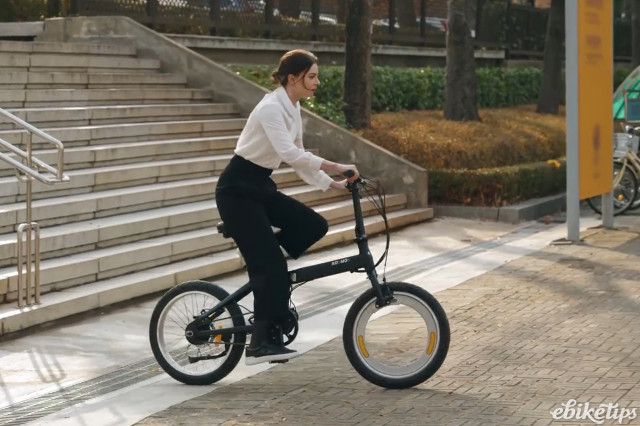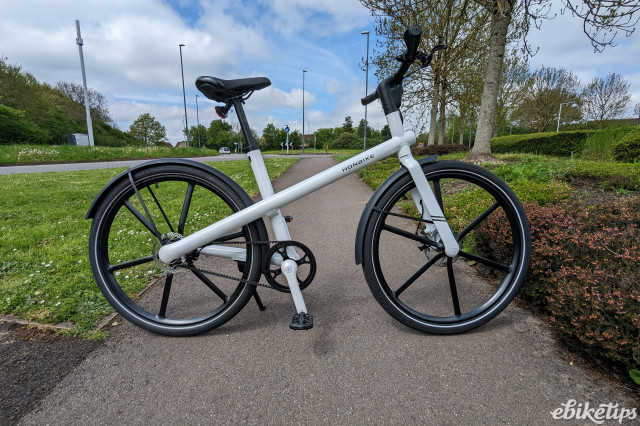Review: Swytch e-bike conversion kit

Overview
- Easy to fit
- Performs well
- Light weight
- Doesn’t leave much space for a front light
- Display not great in bright daylight
- Expensive at full RRP
I reviewed the original Swytch system almost exactly two years ago; overall I liked it, but it was not without its issues. The second generation kit addressed some of those, and is a better system as a result. (We've also now got a 2022 Swytch e-bike conversion kit review which looks at the latest version of the kit, which features a smaller battery.)
Pre-order the Swytch conversion kit here
The system is very simple. You get a battery pack that sits on your handlebars, a cadence sensor that fits on your crank, and a motor built into a wheel to fit your bike. Wheel sizes cover everything from a Brompton up, or if you have something unusual (a penny farthing, or whatever) you can buy the motor unbuilt and do it yourself. Most people, though, will be swapping out their front wheel for a new one.
Swytch majors on the message that the kit is simple to fit, and it is. It took me about half an hour from start to finish. It’s just a case of swapping out the wheel for the new one (and moving the tyre and tube over, of course), adding the cadence sensor to the crank, fitting the bag mount and connecting everything up. Anyone with a basic level of technical competence should be able to sort it out, and a bike shop mechanic would be able to do it with their eyes closed if you don’t trust yourself.
That being said, it’s never quite as easy as advertised. On both occasions I’ve fitted a Swytch system I’ve had to do an amount of bodging to get the system on the bike.
The cadence sensor ring is designed to fit around the bottom bracket axle between the frame and the crank, but our test bike (a pretty standard Specialized hybrid) didn’t have enough space for it to slip in there, so in the end I fixed it to the cranks itself with some Blackmorph and that worked fine.
On both occasions I’ve fitted the system there hasn’t been enough room to get the cadence sensor in behind the ring in an unfettered state. It comes with a hinged plate to adjust the position; I just hacked that off and it fitted fine, held in place with a couple of zip ties.
Anyway, with everything in place it’s a neat system, and barely noticeable, especially now the battery pack bag has shrunk to maybe half of its original size. That has improved the system considerably. For a start it’s not as heavy, so it has less effect on the handling. It’s a noticeable difference: There’s less mass and it doesn’t sit quite as high, and the result is that the bike doesn’t feel quite as top- and front-heavy. On the old system it always felt a bit like you were going to pitch yourself over the bars if you braked too hard on the front. The new, smaller bag is a lot better.
The display has been changed; where before it was an LCD display which gave you speed and odometer readout as well as assistance mode and battery state, now it’s a simple five LEDs for battery and five for assistance. The number of assistance modes has halved, which is very welcome: five is more than enough, and though you probably won’t discern much difference between modes one and two there’s noticeable jumps as the assistance the higher you go. The LEDs aren’t that visible in bright daylight, and the buttons aren’t especially easy to find when you’re wearing gloves, but it’s okay.
I didn’t fit the Swytch system to my own bike. This system went on my friend Lucy’s bike: she’s a very occasional cyclist, and lives just south of Bath where there’s very little flat cycling to be found. Here are her thoughts on the system:
“It’s fair to say that the Swytch system has opened up a whole world of cycling for me. I enjoy cycling, but the hills around here make it pretty difficult, and I always struggle to keep up with my husband Andy when we ride together, which doesn’t really work for either of us. Now I can easily stay with him, and the Swytch system allows me to do as much or as little exercise as I like!
“I do want to exercise when I’m out on my bike, so I mostly have the motor switched off, only turning it on for the hills. Really I only use two modes: three for most of the climbs on my local routes, and five for the really steep ones. I think there are too many modes, really, and I sometimes found it difficult to read the display on the top of the bag.
“The weight was a bit disconcerting at first, but to quote a phrase that’s in heavy rotation right now, it’s become the new normal. You quickly learn to compensate for the extra weight, and adding just 3kg to the bike overall is really impressive. I like the fact that I’m still on my own bike, which I’m comfortable with and I know fits me well: there’s no need for test rides or sizing questions.
“I don’t go out for huge rides, normally an hour or so, and the Swytch has plenty charge to get me round. The recharge time of three hours is impressive too.
“Overall I really like the system, and it seems good value given the £500 pre-order price. I’d have to say that at the full retail price of getting on for twice that it’s definitely out of the price range of many of my friends who would certainly benefit from it, but would probably look at spending less than £300 on a bike to ride for leisure”
So, that’s a thumbs up from Lucy. I did also ride the system on her bike, which was a bit small for me, and it works well. The motor power I’d class as sufficient: it doesn’t have the power of a mid motor or some of the better hub motors, but with a 40Nm rating it’s enough to get me up my benchmark commuting hill (1.5km at an average of 5% with a 12% section) without any great fuss. You start to feel like you’re expected to chip in with some of the work when the road hits about 9-10% but it’s still a whole lot easier than doing it under your own steam, as turning off the assistance will immediately remind you.
The battery’s good for a couple of runs up from town; it doesn’t have a huge range, but that’s not really the point of a system like this, and if your commute is testing its limits then it’s easy to sling the charger in your bag, and quick to recharge at work for the home leg. The quick release bracket on the bag is really easy to use, so taking the bag on and off is simple. There are two capacities, 180Wh and 250Wh, of which our test kit is the smaller; it still gives useful range and you don’t have to use it all the time, especially on the flat.
As to cost - well, at present the system is on pre-order for £399, but that doesn’t include import taxes which will be worked out at the time of import and added. They’re likely to bring the price up to around £500, which is the price I’ve quoted in the article and that I’m using to talk about value. At that kind of money it’s decent value, given the performance you’re getting. You can get a cheaper conversion kit online, sure, but the Swytch is the neatest I’ve seen and a lot less bulky than many you’ll find where the motor alone will weigh the 3kg this entire system adds. The list price is £799 + taxes; at that kind of money it looks significantly worse value for money and I don’t think Swytch’s business model is really to sell them at that price.
So overall, the Swytch kit is an improvement over its predecessor and certainly one to look at if you have a bike you love, but maybe not the legs to get it where you want to go.
1 comments
I bought the original Swytch conversion - it was not a good experience - do careful research before you commit to this system - the reality is not that portrayed in their "fun" videos/advertising













